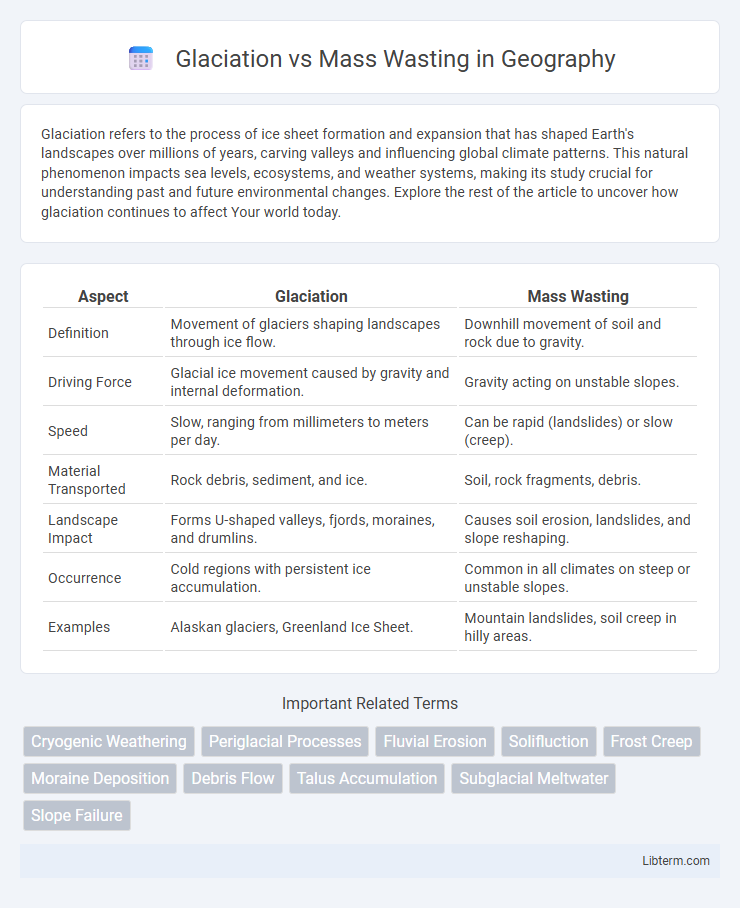Glaciation refers to the process of ice sheet formation and expansion that has shaped Earth's landscapes over millions of years, carving valleys and influencing global climate patterns. This natural phenomenon impacts sea levels, ecosystems, and weather systems, making its study crucial for understanding past and future environmental changes. Explore the rest of the article to uncover how glaciation continues to affect Your world today.
Table of Comparison
| Aspect | Glaciation | Mass Wasting |
|---|---|---|
| Definition | Movement of glaciers shaping landscapes through ice flow. | Downhill movement of soil and rock due to gravity. |
| Driving Force | Glacial ice movement caused by gravity and internal deformation. | Gravity acting on unstable slopes. |
| Speed | Slow, ranging from millimeters to meters per day. | Can be rapid (landslides) or slow (creep). |
| Material Transported | Rock debris, sediment, and ice. | Soil, rock fragments, debris. |
| Landscape Impact | Forms U-shaped valleys, fjords, moraines, and drumlins. | Causes soil erosion, landslides, and slope reshaping. |
| Occurrence | Cold regions with persistent ice accumulation. | Common in all climates on steep or unstable slopes. |
| Examples | Alaskan glaciers, Greenland Ice Sheet. | Mountain landslides, soil creep in hilly areas. |
Introduction to Glaciation and Mass Wasting
Glaciation involves the movement and formation of glaciers, which sculpt landscapes through processes such as erosion, transportation, and deposition of sediments. Mass wasting refers to the gravitational movement of soil, rock, and debris down slopes, driven by factors like water saturation, slope angle, and geological composition. Both processes significantly reshape Earth's surface but operate through distinct mechanisms of material transport and landscape modification.
Defining Glaciation: Processes and Types
Glaciation refers to the process by which glaciers form, advance, and retreat, shaping landscapes through the movement of ice masses. Key processes include accumulation, compaction, and ablation, resulting in distinct landforms such as moraines, drumlins, and fjords. Types of glaciation comprise alpine, occurring in mountainous regions, and continental, covering vast ice sheets like those in Antarctica and Greenland.
Understanding Mass Wasting: Mechanisms and Forms
Mass wasting involves the downhill movement of soil, rock, and debris under the influence of gravity, triggered by factors such as water saturation, slope angle, and seismic activity. Common mechanisms include falls, slides, flows, and creep, each distinguished by the speed and nature of material displacement. Understanding these processes helps in assessing risks and implementing engineering solutions for landslide prevention and slope stabilization.
Key Differences Between Glaciation and Mass Wasting
Glaciation involves the movement of ice masses, shaping landscapes through erosion, transportation, and deposition, whereas Mass Wasting refers to the downslope movement of soil and rock under gravity without a transporting agent like ice or water. Glaciation creates distinctive landforms such as U-shaped valleys and moraines, while Mass Wasting results in features like landslides, rockfalls, and debris flows. The timescale of glaciation is typically longer, occurring over thousands of years, whereas mass wasting events can be rapid and sudden.
Geological Impacts of Glaciation
Glaciation profoundly shapes landscapes through processes like erosion, transportation, and deposition, creating features such as U-shaped valleys, fjords, and moraines. The immense pressure and movement of glaciers grind down bedrock, contributing to soil redistribution and altering drainage systems. These geological impacts influence long-term topography and sediment distribution patterns, crucial for understanding past climate and environmental changes.
Landform Development from Mass Wasting
Mass wasting significantly shapes landform development through processes like landslides, soil creep, and rockfalls, which contribute to slope modification and sediment redistribution. These gravity-driven movements create features such as talus slopes, mudflows, and scarps that alter the landscape rapidly compared to the gradual erosion by glaciation. Mass wasting often interacts with other geomorphic processes, accelerating landscape evolution in mountainous and hilly terrains by destabilizing slopes and facilitating sediment transport.
Climate Influence on Glaciation and Mass Wasting
Climate plays a crucial role in glaciation by directly affecting temperature and precipitation patterns, which determine glacier formation, growth, and retreat. In contrast, mass wasting is influenced by climatic factors such as rainfall intensity and freeze-thaw cycles, which impact soil moisture levels and slope stability. Understanding the interplay between climate variables and geomorphic processes is essential for predicting landscape changes caused by glaciation and mass wasting.
Environmental and Human Impacts
Glaciation shapes landscapes through erosion and deposition, creating features like U-shaped valleys and moraines that influence ecosystems and water resources. Mass wasting, including landslides and rockfalls, rapidly alters terrain, threatening infrastructure and human settlements with damage or loss. Both processes impact soil stability, vegetation patterns, and groundwater flow, affecting agriculture and biodiversity in affected regions.
Case Studies: Glaciated Terrains vs Mass Wasting Regions
Glaciated terrains such as the Swiss Alps showcase prominent striations, U-shaped valleys, and moraines formed by the dynamic advance and retreat of glaciers, revealing extensive erosional and depositional processes over millennia. In comparison, mass wasting regions like the Himalayan slopes experience rapid landslides, debris flows, and soil creep driven by gravitational forces intensified by heavy rainfall and seismic activity, resulting in frequent landscape instability and sediment redistribution. Case studies from these contrasting environments highlight the dominant geomorphic agents shaping mountainous landforms: ice-driven glacial sculpting versus gravity-induced mass movement.
Conclusion: Comparing Roles in Landscape Evolution
Glaciation shapes landscapes primarily through processes like erosion, transportation, and deposition of sediment, forming distinctive features such as U-shaped valleys, fjords, and moraines. Mass wasting contributes to landscape evolution by directly moving rock and soil downslope, often triggered by gravity, weathering, or water saturation, resulting in landslides, rockfalls, and debris flows. Together, glaciation and mass wasting interact to sculpt landforms, with glaciation providing large-scale modification and mass wasting facilitating continuous surface adjustment.
Glaciation Infographic

 libterm.com
libterm.com